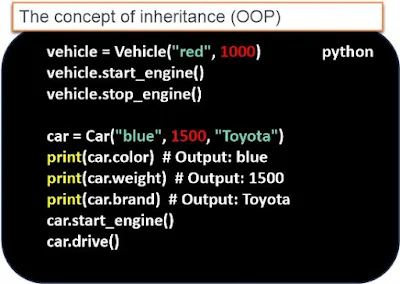"Exploring Inheritance: A Key OOP Principle for Code Reusability"
Learn about inheritance, a fundamental concept in Object-Oriented Programming (OOP), that enables classes to inherit properties and behaviors from parent classes.
Discover how inheritance promotes code reusability and facilitates the creation of specialized classes.
"Exploring Inheritance: A Key OOP Principle for Code Reusability"
Inheritance is a fundamental concept in Object-Oriented Programming (OOP) that allows classes to inherit properties and behaviors from parent classes.
It provides a way to establish relationships between classes, creating a hierarchy of classes where child classes inherit the characteristics of their parent classes.
When a class inherits from another class,
it gains access to all the attributes (variables) and methods (functions) defined in the parent class.
This means that the child class can reuse and extend the functionality of the parent class without having to redefine it from scratch.
This promotes code reuse, as common attributes and behaviors can be defined in a single place and shared among multiple classes.
To establish inheritance,
the child class is defined by specifying the parent class from which it inherits.
This is done using the syntax 'class ChildClass(ParentClass):'.
The child class can then add its own attributes and methods, as well as override or extend the ones inherited from the parent class.
Inheritance allows for the creation of specialized classes that inherit and build upon the properties and behaviors of more general classes.
For example, consider a class hierarchy representing different types of vehicles.
The parent class could be a general "Vehicle" class with attributes like "color" and "weight" and methods like "start_engine" and "stop_engine".
The child classes, such as "Car", "Motorcycle", and "Truck", can inherit these attributes and methods and also define their specific attributes and methods.
This way, the child classes can benefit from the common functionalities defined in the parent class while adding their own specialized behaviors.
Inheritance also facilitates hierarchical class structures, where multiple levels of inheritance can exist.
A child class can itself become a parent class for another class, creating a chain of inheritance.
This allows for the organization and classification of classes based on their relationships and shared characteristics.
A Key OOP Principle
Overall, inheritance is a powerful mechanism in OOP that promotes code reuse, modularity, and extensibility.
It enables the creation of specialized classes by inheriting and building upon the properties and behaviors of more general classes, leading to more efficient and maintainable code.
In this example, the 'Vehicle' class has two attributes, 'color' and 'weight', which are initialized through the constructor ('_ _init_ _' method).
It also has two methods, 'start_engine' and 'stop_engine', which simulate starting and stopping the engine.
Now, let's create a child class called "Car" that inherits from the 'Vehicle' class.
The 'Car' class will inherit the attributes and methods defined in the 'Vehicle' class and can also have its own specialized attributes and methods.
In this example, the 'Car' class inherits from the 'Vehicle' class using the 'Vehicle' class as the parent class in parentheses after the class name. The 'Car' class has an additional attribute called 'brand'. In the '_ _init_ _' method of the 'Car' class, we call the parent class's '_ _init_ _' method using the 'super()' function to initialize the inherited attributes ('color' and 'weight'). Additionally, the 'Car' class has its own method called 'drive' which simulates driving the car.
Now, we can create instances of the 'Vehicle' and 'Car' classes and see how inheritance works:
-------------------
thank you ~~
<To read the previous article>
👉"Exploring OOP Principles: Inheritance, Polymorphism, and
Encapsulation"
👉"Python Advanced Concepts: From Object-Oriented Programming to Lambda Functions"




